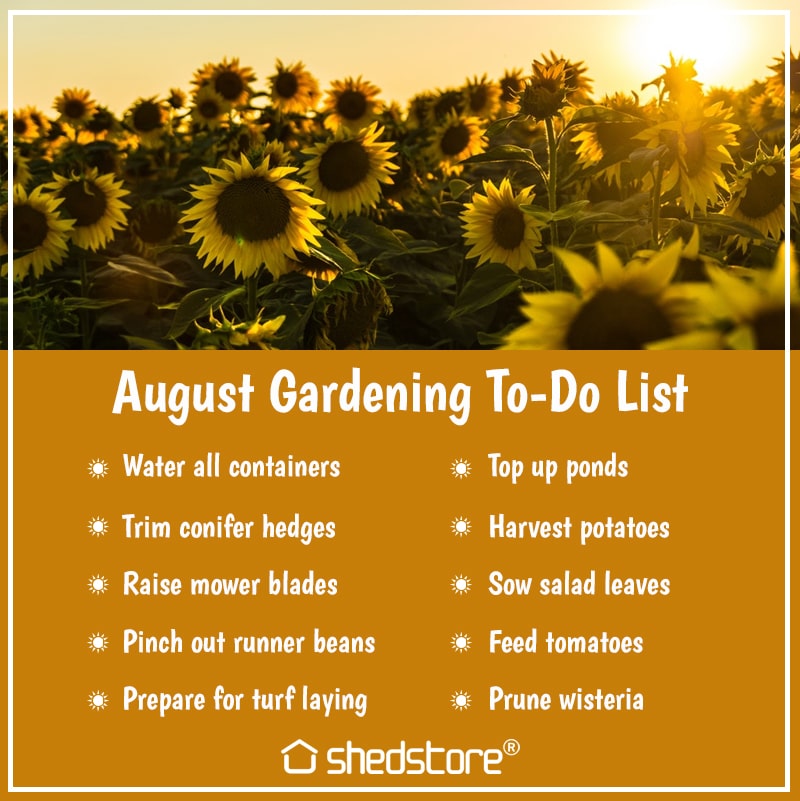
Hello August!
The key tasks for an organised, growing, healthy garden for this month are:
1. Water all containers
Plants growing in containers get thirsty. Consider fitting micro irrigation to your pots if you are going away on holiday for a fortnight (only if your neighbours can’t do your watering tasks!) and definitely group pots together in a shadier part of the garden. Even sun lovers will put up with a little bit of shade if it means less stress and lots of water from a handy hosepipe or watering can.
Water the surface of the compost and DO NOT spray over the foliage.
2. Trim conifer hedges
Now is a great time to trim up your yew and other conifer hedges. Not only will it keep things looking ship-shape, the resultant new growth will have time to mature before winter.
3. Raise mower blades
Chances are that the lawn will be knee high when you return from your summer holiday. In hot dry weather, raise the blades of your mower. This reduces the evaporation of water from the soil surface between the blades of grass. Also, cutting off a bit an overgrown lawn at a time reduces stress on the grass. Mowing it short as soon as you return home will result is a hard, yellow lawn.
4. Pinch out runner beans
Runner beans will be merrily waving from the tops of canes and any flowers they produce from now will not have time to produce pods. With the help of a step ladder, nip out the tops of all runner bean plants you can reach. It will allow the plants to concentrate their efforts into turning existing flowers into tasty pods.
5. Prepare for turf laying
Do not lay turf now (too dry, too hot) but do start preparing the soil. Start to rid the soil of all stones, debris and anything lumpy and bumpy. Do it every week until autumn arrives and it is time for laying the turf. The trick to laying a top-class lawn is the preparation.
6. Top up ponds
In hot weather, pond will lose a substantial amount of water through evaporation. Top it up with rainwater from your water butt or, if that is low or being used elsewhere in the garden, tap water will have to do. Ideally let the tap water stand for an hour or two in a bucket before adding to the pond.
7. Harvest potatoes
Once plants have flowered, the potatoes are ready to eat. Ensure you get all spuds from the soil as anything left will only attract slugs. Not only that, if left over winter they will grow next spring and will undoubtedly spoil your onion bed or cabbage patch or whatever you are growing in its place next year. Clear away all leaves and stems to prevent any chance of diseases getting a hold. Store spuds in large sturdy paper sacks (greengrocers have loads for free) in the dark before use.
8. Sow salad leaves
Gaps begin to appear in the veg plot, especially when all those potatoes are harvested. Don’t let a centimetre of soil go to waste - sow beetroot seeds and salad leaves and spring onions and radishes and both Chinese and spring cabbage and corn salad. And you thought it was going to get quieter in the garden - not a chance!
9. Feed tomatoes
Tomatoes are full steam ahead and are using all nutrients in compost and soil. Feed every week with fertilizer formulated for tomatoes and other fruiting crops. They are high in potash and are exactly what tomatoes (and cucumbers) need right now.
Regular waterings reduce a nasty condition called blossom end rot (where the ends of the fruits turn brown - yuk!) and you add the much needed potash to allow the fruits to develop.
10. Prune wisteria
There are two times of the year when you need to give your wisteria some care and attention. Now is one of them. Cut out all the long whippy growths back to about 10cm of the main stems. Leave other stems alone. This tidies up the plant and allows effort to be concentrated into the flower buds that are forming on the main structure of the plant.




